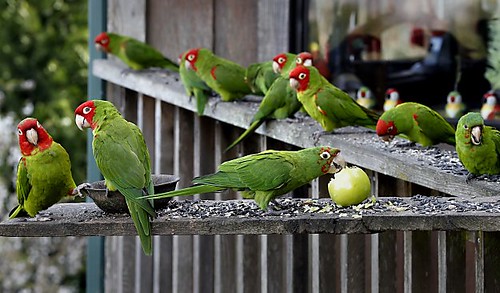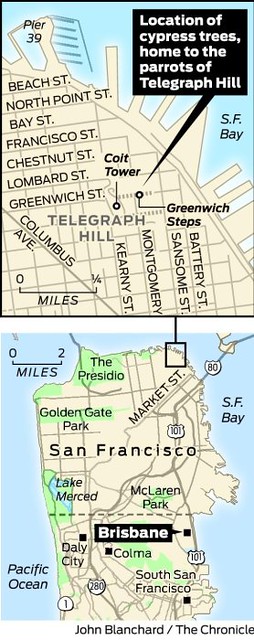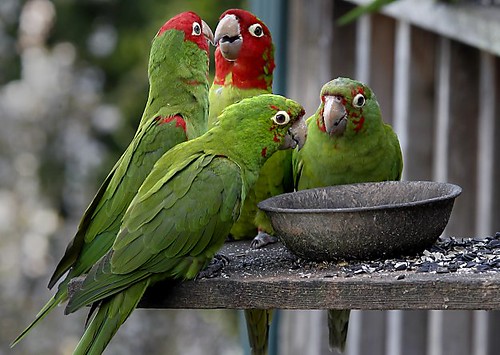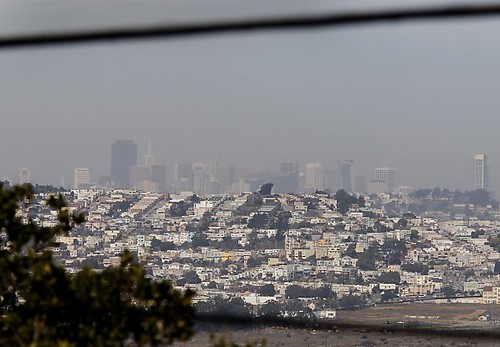 Already immortalized in a book and movie, about 100 of the wild parrots from Telegraph Hill are living on the slopes of San Bruno Mountain, where they've found the juniper and hawthorn berries to their liking. Photo: Brant WardThe wild parrots of Telegraph Hill, apparently jaded by city life, have headed for the suburbs.
Already immortalized in a book and movie, about 100 of the wild parrots from Telegraph Hill are living on the slopes of San Bruno Mountain, where they've found the juniper and hawthorn berries to their liking. Photo: Brant WardThe wild parrots of Telegraph Hill, apparently jaded by city life, have headed for the suburbs.
The goofy, green birds are now the mild parrots of Brisbane.
"We've got a pool, a park, and now we've got parrots. They make more noise than the airplanes," said Ron Davis, a Brisbane real estate agent and longtime resident.
 S.F. parrots on the mapSan Francisco's famed flock of cherry-headed conures, immortalized in an award-winning movie and book, has become so populous that about 100 or so birds have fled San Francisco for the verdant slopes of San Bruno Mountain, where they're feasting on juniper and hawthorn berries and delighting the locals with their acrobatics.
S.F. parrots on the mapSan Francisco's famed flock of cherry-headed conures, immortalized in an award-winning movie and book, has become so populous that about 100 or so birds have fled San Francisco for the verdant slopes of San Bruno Mountain, where they're feasting on juniper and hawthorn berries and delighting the locals with their acrobatics.
Another 100 or so are still flapping around the northern edge of San Francisco, but the flock appears to have branched beyond the foggy confines of the waterfront, probably in search of food, said Mark Bittner, author of the best-selling "The Wild Parrots of Telegraph Hill."
"All I care about is that they stay wild and free," said Bitt- ner, who still lives on Telegraph Hill but no longer serves as the flock's unofficial caretaker.
The winged critters gained international fame in the mid-2000s, when Bittner wrote his book about his life with them and starred in a documentary of the same name.
His advice to the bird-lovers of Brisbane: "Just enjoy them. They're fun. They make people laugh. And don't worry, they never scream at night."
They're a noisy bunch
 The parrots visit the home of Joe Sulley a couple times a day for seed. The wild parrots of Telegraph Hill (San Francisco) have moved onto the suburbs. Brisbane, Calif. residents have been seeing flocks of parrots visiting hillsides, oak trees and a few neighbors who leave seed out. Photo: Brant Ward They're not shy during the day, though. Many Brisbane residents said they heard the parrots' high-decibel "cack-cack" long before they saw the birds' trademark chartreuse plumage.
The parrots visit the home of Joe Sulley a couple times a day for seed. The wild parrots of Telegraph Hill (San Francisco) have moved onto the suburbs. Brisbane, Calif. residents have been seeing flocks of parrots visiting hillsides, oak trees and a few neighbors who leave seed out. Photo: Brant Ward They're not shy during the day, though. Many Brisbane residents said they heard the parrots' high-decibel "cack-cack" long before they saw the birds' trademark chartreuse plumage.
The birds squawk and swoop along the mountainside like a gang of thrill-seeking teenagers, periodically alighting on telephone wires or gorging themselves on cherry blossoms. It's as if sleepy, tucked-away Brisbane has been taken over by green monkeys.
 From the highest points on San Bruno mountain, one can see downtown San Francisco, perhaps where the parrots originate. The wild parrots of Telegraph Hill (San Francisco) have moved onto the suburbs. Brisbane, Calif. residents have been seeing flocks of parrots visiting hillsides, oak trees and a few neighbors who leave seed out. Photo: Brant WardOne of the parrots' favorite pit stops is Joe and Jeri Sulley's back deck. The Sulleys keep a supply of raw, unsalted sunflower seeds scattered on the deck railing.
From the highest points on San Bruno mountain, one can see downtown San Francisco, perhaps where the parrots originate. The wild parrots of Telegraph Hill (San Francisco) have moved onto the suburbs. Brisbane, Calif. residents have been seeing flocks of parrots visiting hillsides, oak trees and a few neighbors who leave seed out. Photo: Brant WardOne of the parrots' favorite pit stops is Joe and Jeri Sulley's back deck. The Sulleys keep a supply of raw, unsalted sunflower seeds scattered on the deck railing.
"For a couple of retired hippies like us, this is just the greatest thing in the world," said Joe Sulley, a retired surveyor who's become so friendly with the parrots they occasionally perch on him. "Parrots on my head? It's fabulous."
Bird on the wire
 Wild parrot. Photo: Brant WardResidents first spotted the parrots about three years ago. Danette Davis, Ron Davis' wife, said she was in her house one day when she heard a commotion so loud her dog started barking.
Wild parrot. Photo: Brant WardResidents first spotted the parrots about three years ago. Danette Davis, Ron Davis' wife, said she was in her house one day when she heard a commotion so loud her dog started barking.
"I thought, 'What the heck is that?' I went out and saw something green on the wire," she said. "I thought, 'Oh my God, it's a parrot.' They weren't singing; it was more like talking. They chatter."
Gradually, the Brisbane parrots increased from a handful to the 100 or so who appear to live there full time, as much a fixture of the 4,000-resident town as the Eagles Lodge, 23 Club saloon and jetliners from SFO overhead.
They're apparently drawn to the abundance of juniper trees and shelter of San Bruno Mountain, Bittner said.
Some of the birds probably circulate back to San Francisco, where the flock originated in the late 1980s and early 1990s, he said.
Most likely, the original Telegraph Hill parrots escaped from a pet importer and found a welcoming habitat in the trees of San Francisco.
Although they're native to South America, the parrots have adapted well to big-city life and don't appear bothered by the chilly weather or curious humans.
Don't feed the birds
 If you want to attract wild parrots, Joe Sulley suggests large bags of sunflower seeds. The wild parrots of Telegraph Hill (San Francisco) have moved onto the suburbs. Brisbane, Calif. residents have been seeing flocks of parrots visiting hillsides, oak trees and a few neighbors who leave seed out. Photo: Brant WardIn fact, they've been such a hit in San Francisco that the city passed a law in 2007 prohibiting people from feeding them. So many humans were offering treats that the birds were becoming dangerously tame and vulnerable to capture and sickness.
If you want to attract wild parrots, Joe Sulley suggests large bags of sunflower seeds. The wild parrots of Telegraph Hill (San Francisco) have moved onto the suburbs. Brisbane, Calif. residents have been seeing flocks of parrots visiting hillsides, oak trees and a few neighbors who leave seed out. Photo: Brant WardIn fact, they've been such a hit in San Francisco that the city passed a law in 2007 prohibiting people from feeding them. So many humans were offering treats that the birds were becoming dangerously tame and vulnerable to capture and sickness.
So far, Brisbane has no such law on the books. Still, people should resist the urge to feed the parrots, no matter how friendly they are, said Victor Alm, zoological manager at the Oakland Zoo.
"They've obviously managed to adapt here and thrive," he said. "They don't need us. This is a great way for people to appreciate them from afar."
 The abundance of trees and natural shelter have made San Bruno Mountain a suitable new home for the colorful conures. Photo: Brant Ward
The abundance of trees and natural shelter have made San Bruno Mountain a suitable new home for the colorful conures. Photo: Brant Ward